February 2005 // Volume 43 // Number 1 // Commentary // 1COM2
An Extension Role in Foreign Trade
Abstract
A distinct thrust toward internationalizing Extension has been Washington
State University's innovative intervention in foreign trade. An Extension trade
specialist led numerous colleagues in enhancing the movement of many agricultural
products and commodities to offshore markets. Foreign trade is and will continue
to be central to American agriculture, and this example demonstrates Extension
can be the glue that brings that together.
Introduction
American Extension workers have always assisted farmers and rural families in improving their lives through applied science and enhanced productivity. Then Extension specialists became involved in value-added production as the food processing industry expanded. As production grew and the U.S. economy improved its balance of trade, the export sector of agriculture took on critical significance. Domestic needs were exceeded for many commodities. Farm states with maritime and lake ports increasingly looked to offshore destinations as markets. Agricultural trade that once traversed the U.S. interior began to embrace the sea-lanes to Europe, the Far East, and even the Third World. Overland traffic shifted north and south towards America's borders.
Around 1985, a number of international trade development centers were established at selected land-grant universities, with federal, state and agri-industry support, and the IMPACT Center was established at Washington State University. Washington was identified as a highly export-dependent agricultural state, ranking second in export product diversity, third in export value, and arguably first in percentage of agricultural revenue from exports. Other developments in the late 1980's/early 1990's that added to the export trade focus of the Pacific Northwest and America in general were finalization and implementation of NAFTA and progress made toward other trade liberalization agreements.
Extension workers across the nation advised and assisted with crops and commodities that found their way to markets around the world. However, many potential exporters did not understand the myriad factors at work in world marketplaces. Foreign freight forwarding, export financing, documentation of trade, shipping regulations, and phytosanitary constraints were unfamiliar to many producers. Cultural sensitivities, language awareness, international business practices, transportation options, distribution systems, product shelf-life requirements, quality concerns, pricing, seasonality, consumer behavior, and dietary customs constituted another array of knowledges to be mastered.
Enter Extension
Washington State University addressed the information gap by creating the position of Extension Trade Specialist (ETS), to be filled by an individual who matched international mentoring skills with the expertise of a cadre of other Extension workers in a trade enhancement and support program. This individual would understand offshore markets, explore and expand new markets, reduce barriers to trade, conduct competitive assessments, and disseminate export market information among growers and shippers. Similar Extension activities and export information programs occurred throughout the nation. They were endorsed by USDA and state departments of agriculture and supported abroad by FAS at export destinations.
Intense Extension activity was sustained at Washington State University for nearly 10 years involving the ETS and several Extension agents and specialists in many countries. Today, involvement in foreign trade is a matter of program emphasis by individual Extension faculty members or states but remains a critical and highly valuable contribution in the U.S. and internationally.
Important to foreign trade Extension at home is opportunity for Extension workers who want to take on the task. Commodity groups and trade promotion organizations have materials and access to trade enhancement funds to assist and sometimes underwrite Extension functions. Resource people team with Extension personnel in the instruction of potential exporters. Foreign freight forwarders, port authority personnel, export banking institutions, and state departments of agriculture have resources and personnel to complement Extension efforts. Experienced exporters also share valuable experience.
Dynamics
The dynamics of overseas markets are subject to frequent and sometimes dramatic changes. A traditional market may dry up overnight. Such changes may have economic, political, phytosanitary, pathogenic, or regulatory origins, or any combination of these. Market shifts may occur as outcomes of effective promotions or popular trends. Extension workers may play fact-finding roles in those instances not only for the exporter community but for overseas clients as well.
Extension professionals also promote the quality and wholesomeness of American products and commodities overseas. It is critical that they be forthright with international clients. Importers place great trust in university academics, and it is not tenable to betray that trust. Extension faculty can open doors, share confidences, and discover facts in the international marketplace that can benefit the flow of trade in all directions. Genetically modified organisms and genetically modified material in agricultural commodities for export may currently be the most controversial matter in world trade. It would behoove the Extension worker to remain neutral on this issue.
Trading styles must also be learned by Extension personnel. Traders trade in different ways in different areas of the world. The formal protocol of the Japanese boardroom contrasts with the more flamboyant Brazilian style. Argentine opulence in Buenos Aires may differ markedly from less obvious Bangladeshi wealth in Chittagong. The textbook business deal with Canadian or English clients may be a different experience from the social event that an Arab or Colombian deal becomes. In certain governments, it is not uncommon to have a single buyer for a given U.S. commodity. In both Egypt and Algeria, for years, the Minister of Supply was the sole person responsible for the food security of the nation.
Examples on the Ground
Some examples of important commodity experiences in offshore markets illustrate types of interventions mentioned here. They also suggest a continuing and perhaps enhanced role in foreign trade for Extension workers across the nation. The export trade in U.S. meats is very active. Extension workers were central to enhancement of the flow of high quality chilled boxed beef from the Pacific Northwest to markets in Japan and Korea, in keen competition with Australia and New Zealand, and the two-way exchange of beef and feeder cattle between the U.S. and Canada. Not only was an understanding of Asian beef import quota systems and NAFTA critical to that achievement, but also close collaboration with FAS/USDA and the U.S. Meat Export Federation.
Attention to the number one apple market in Mexico required constant attention and was sustained in part by the hard work of Extension personnel. Transportation options were evaluated and cross-border relations fostered, including orchard visits to the U.S. by Mexican buyers. Balanced information was supplied on dumping disputes, client after-service was promoted, and field assistance was lent to Mexican orchardists on pest and disease control. As a sideline to the apple trade, Extension faculty promoted the top-loading of fruit shipments with Pacific Northwest Christmas trees seasonally and conducted tree-care education in Mexico. Those measures helped increase the market share for trees one hundred percent in a single season.
Offshore markets for Pacific Northwest peas, lentils, and chickpeas are needed for the industry to remain viable against Canadian, Mexican, Turkish, and Hungarian competition. Extension workers introduced the Palouse red lentil to international markets and made inroads into establishing a viable market for that crop. Extension personnel worked to establish Colombia as an important buyer of local chickpeas and assessed the competitiveness of Hungary and Canada in the erosion of the dry green pea market in India, ultimately recommending the transshipment of peas through the Canadian port of Vancouver to access favorable sea freight rates to the sub-continent. Finally, persistent work led to strengthened shipments of dry yellow peas to upland Venezuela.
Hop production is critical to the Washington agricultural economy, and the state leads the nation in production and export. Almost all the hops produced are channeled into beer production, and much of that is offshore. Considerable product finds its way to beer producers in Mexico and Brazil as well as lesser amounts to other Latin American nations. Both bitter and aromatic hops are typically blended by the world's brewmasters in creating good-tasting beers. The local product has been transformed over the years from baled cones to isomerized extract, which looks almost like a refined honey and which is economically shipped and easily stored.
After conducting an assessment of Canadian canola production in the late 1990's, an Extension team visited Japanese trading companies and oil mills in a successful mission to build bridges to Pacific Northwest canola production sources. Other local Extension colleagues have worked extensively on alfalfa exports and the lucrative offshore movement of timothy hay. Still others have assisted the pork industry to find a circuitous sea-lane to the Far East. At least one professional has become a world expert on sweet cherries, which consistently target Japan and Taiwan as prime time yearly markets, while American and recently Washington premium wines have found Extension experts centrally placed in support of their production, promotion, and world fame. The list goes on. Extension people have been at the cutting edge of forest products, seafood, dairy genetics, and nursery stock and pathfinding in the seed industry.
Scenes from the Marketplace
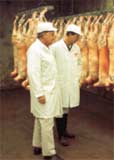 |
 |
 |
 |
Inspecting lamb in Canada |
Meat talks in Japan |
Beef Retail in Tokyo |
Seeing pulses in Turkey |
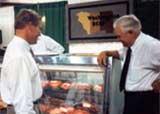 |
 |
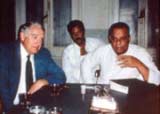 |
Marketing Washington beef |
Wagyu carcass sales |
Lentil trading in Egypt |
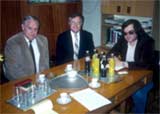 |
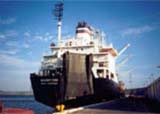 |
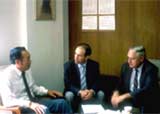 |
Pea research in Hungary |
Shipping out |
Korean meats trading |
Conclusion
Foreign trade is and will continue to be central to American agriculture, and Extension can be the glue that brings that together. The experience begins with years of insights into production agriculture, risk management, pest control, quality improvement, and the wholesomeness of food and a commitment to quality. The next step is a natural for Extension workers. It involves a respect for people of all cultures and a belief that a trading world is a sharing world and that a sharing world is the best world.
